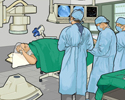Right heart ventricular angiography
Angiography - right heart; Right heart ventriculography
Right heart ventricular angiography is a test that images the right chambers (atrium and ventricle) of the heart.
How the Test is Performed
You will get a mild sedative 30 minutes before the procedure. A cardiologist will cleanse the site and numb the area with a local anesthetic. Then a catheter will be inserted into a vein in your neck, arm, or groin.
The catheter will be moved into the right side of the heart. As the catheter is advanced, the doctor can record pressures from the right atrium and right ventricle.
Contrast material ("dye") is injected into the right side of the heart. It helps the cardiologist determine the size and shape of the heart's chambers and evaluate their function as well as the function of the tricuspid and pulmonary valves.
The procedure will generally last less than 1 hour but may be considerably longer.
How to Prepare for the Test
You will not be allowed to eat or drink for 6 to 8 hours before the test. The procedure takes place in the hospital. Generally, you will be admitted the morning of the procedure. However, you may need to be admitted the night before.
A health care provider will explain the procedure and its risks. You must sign a consent form.
How the Test will Feel
You will be given local anesthesia where the catheter is inserted. Afterward, the only thing you should feel is pressure at the site. You will not feel the catheter as it is moved through your veins into the right side of the heart. You may feel a flushing sensation or the feeling that you need to urinate as the dye is injected.
Why the Test is Performed
Right heart angiography is performed to assess the blood flow through the right side of the heart.
Normal Results
Normal results include:
- Cardiac index is 2.8 to 4.2 liters per minute per square meter (of body surface area)
- Pulmonary artery systolic pressure is 17 to 32 millimeters of mercury (mm Hg)
- Pulmonary artery mean pressure is 9 to 19 mm Hg
- Pulmonary diastolic pressure is 4 to 13 mm Hg
- Pulmonary capillary wedge pressure is 4 to 12 mm Hg
- Right atrial pressure is 0 to 7 mm Hg
What Abnormal Results Mean
Abnormal results may be due to:
- Abnormal connections between the right and left side of the heart
- Abnormalities of the right atrium, such as atrial myxoma (rarely)
- Abnormalities of the valves on the right side of the heart
- Abnormal pressures or volumes, particularly lung problems
- Weakened pumping function of the right ventricle (this could be due to many causes)
Risks
Risks of this procedure include:
- Cardiac arrhythmias
- Cardiac tamponade
- Embolism from blood clots at the tip of the catheter
- Heart attack
- Hemorrhage
- Infection
- Kidney damage from the dye
- Low blood pressure
- Reaction to contrast dye or sedating medicines
- Stroke
- Trauma to the vein or artery
Considerations
This test may be combined with coronary angiography and left heart catheterization.
References
Kern MJ, Seto KH, Herrmann J. Invasive hemodynamic diagnosis of cardiac disease. In: Libby P, Bonow RO, Mann DL, Tomaselli GF, Bhatt DL, Solomon SD, eds. Braunwald's Heart Disease: A Textbook of Cardiovascular Medicine. 12th ed. Philadelphia, PA: Elsevier; 2022:chap 22.
Patel MR, Bailey SR, Bonow RO, et al. ACCF/SCAI/AATS/AHA/ASE/ASNC/HFSA/HRS/SCCM/SCCT/SCMR/STS 2012 appropriate use criteria for diagnostic catheterization: a report of the American College of Cardiology Foundation Appropriate Use Criteria Task Force, Society for Cardiovascular Angiography and Interventions, American Association for Thoracic Surgery, American Heart Association, American Society of Echocardiography, American Society of Nuclear Cardiology, Heart Failure Society of America, Heart Rhythm Society, Society of Critical Care Medicine, Society of Cardiovascular Computed Tomography, Society for Cardiovascular Magnetic Resonance, and Society of Thoracic Surgeons. J Am Coll Cardiol. 2012;59(22):1995-2027. PMID: 22578925 www.ncbi.nlm.nih.gov/pubmed/22578925.
Valente AM, Dorfman AL, Babu-Narayan SV, Krieger EV. Congenital heart disease in the adolescent and adult. In: Libby P, Bonow RO, Mann DL, Tomaselli GF, Bhatt DL, Solomon SD, eds. Braunwald's Heart Disease: A Textbook of Cardiovascular Medicine. 12th ed. Philadelphia, PA: Elsevier; 2022:chap 82.
Cardiac catheterization - indications
Animation
Heart - section through the middle - illustration
Heart - section through the middle
illustration
Heart - front view - illustration
Heart - front view
illustration
Review Date: 10/26/2022
Reviewed By: Michael A. Chen, MD, PhD, Associate Professor of Medicine, Division of Cardiology, Harborview Medical Center, University of Washington Medical School, Seattle, WA. Also reviewed by David C. Dugdale, MD, Medical Director, Brenda Conaway, Editorial Director, and the A.D.A.M. Editorial team.












